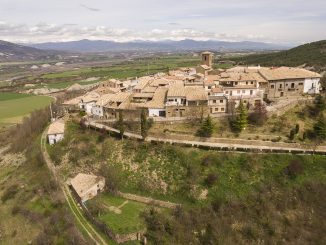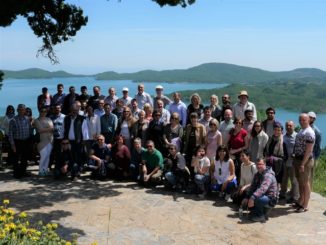 By Maria Rodriguez Beperet, Land Rights Campaign Intern for Eco Ruralis
By Maria Rodriguez Beperet, Land Rights Campaign Intern for Eco Ruralis
While simplification is often called for nefariously, by agribusiness trying to get rid of environmental protections, it is also the case that from a peasant farmers’ perspective, the forms and processes which accompany funding and supports are often very complex and convoluted. This can mean that, ironically, the ones who often call for simplification – agribusiness interests – are also the only ones with the staff, time and expertise to actually access funds. So yet again peasants loose out. María Rodríguez of Eco Ruralis reports.
The CAP is a complex European package of policies which is not always adapted to regional realities. CAP schemes are barely accessible in certain contexts. However, it should not be forgotten that at the very end of any strategy there are real, flesh-and-blood people. The capacity of the policies to be adapted and implemented is essential so that they actually reach the population. Romania holds the second worst ranking in the European Union in terms of CAP funds absorption. Based on that, the allocation of payments for the period 2014-2020 needs to improve and actually reach those who really need it.
Romanian politicians want to move towards a modern and competitive economy that relies less and less on peasant agriculture. Interestingly, the European Common Agriculture Policy (CAP) has aspects which can bee seen to be supportive of peasant farming. The first official version of the Romanian Rural Development Plan (NRDP) for the period 2014-2020 (based on the CAP regulations) shows a major focus on small farmers as essential agents to keep sustainable agriculture and rural landscapes alive. Both the CAP and the NRDP are still focused on the economic aspect of agriculture; the need for (more sustainable) capitalized farms is seen as a must in the purposed measures (see for instance sub-measure 6.3 “Business to start up aid for development of small farms”). There it is, then, a (new) CAP that theoretically wants to assist rather than extinguish the peasant world.
What concerns us here is how this is promoted and to what extent funding actually reaches peasants. Even when the best intentions are pushed forward (for instance through Axis 4, “local development”), the CAP does not seem to ,as it were, ring the doorbells of Romanian common rural households. Because of the complexities of this policy, the CAP funds are usually won by big farmers who have the resources to reach them; or urban and highly-educated individuals that have the knowledge to build targeted projects and hence access funding. This is definitely not relevant to the average peasant.
It is important to highlight here that big corporations are nowadays pushing for a simplification of the CAP. Agribusinesses are interested in lowering the regulations in order to avoid being constrained by high standards that will hamper their economic growth. However, these purposes are different (and even contrary) to our claims. We defend a simplification which improves the peasants´ access to subsidies for the wellbeing of the small farmers, and not corporate tricks.
High levels of bureaucracy, complex procedures, delays, lack of information, corruption, and deficits in the local governments are again and again responsible for systematic failures, and this keeps people from accessing funding. For the CAP period 2007-2013, Romania received over 13 billion Euros; almost 6 billion for agricultural direct payments (Pillar I) and 8 for rural development (Pillar II). In terms of purely agricultural support, the country did well, with an absorption rate of funds from Pillar I of almost 90%. A different story relates to Pillar II, where the rural development and agri-environmental measure reside. Pillar II has an absorption rate below 60%. Money is not distributed, projects are paralyzed … and this does not only affect the CAP. As an example, from the more than 19 billion Euros that Romania received from the European Union as structural and cohesion funds between 2007 and 2013, only around 40% have been allocated. Where is the success here?
With the new CAP period (2014-2020) about to start and the Romanian new official version of the NRDP launched just 6 months ago, the practicalities of the implementation are a major issue that should be acknowledged and addressed. If 10 billion Euros are going to be given to agriculture and 7 billion to rural development, every effort must be made so the money reaches people who really need it.
Let’s focus on Pillar II supports. In order to get funding from the budget for rural development, a project must be sent to the Ministry of Agriculture and Rural Development. It has to be presented at the right moment, when the application period is open it is announced on line. These applications are complex to understand and the writing of the projects a tedious task for those who are not used to them – that’s most of us. Here is where the local governments and private consulting agencies should take the leading role. In addition, even when a project is approved, bank loans are necessary to start it.
Applying for funding for a Pillar II project is a bureaucratic process which furthermore is not facilitated by the local Romanian officials. There is a lack of information about the CAP and its possibilities at the village level; the internet for instance is not an efficient informative tool for rural Romania. Local administrators usually lack knowledge, resources and/or interest to help farmers to build up their project applications and private consultants cost money. In addition, consultants are not always the most reliable facilitators because profit is involved in the process. Furthermore, the banks do not have confidence in agricultural endeavors and barely give loans to small farmers.
Peasants are not used to these complex procedures. All this bureaucracy should be addressed if the CAP is to make an effect at the ground level. Some of the purposed solutions are:
- A better promotion of the possibilities offered by the CAP at the local level
- Facilitation of guidance for peasant farmers
- Decentralization (or regionalization) in order to reach people more accurately
- Simplification of procedures and requirements (without using this as a way to get rid of important environmental protections)
- Stable governance and training for the local entities
- A set of guidelines and tools for an effective implementation of the CAP must be established, although it must always be flexible according to context-specific needs.
If a policy does not reach those ostensibly targeted it is useless. A genuine peasant-orientated simplification – and not a simplification to allow agribusiness to trash the environment – would help to avoid elite fund-grabbing.
More from Eco Ruralis
- Of Fairy Orchards, Biodiversity & Octogenarian Wisdom
- Illegal GM soy discovered in Romania, claim Greenpeace.
- Eastern Europe against TTIP Trojan Horse
- Return of the Roman General: Land Grabbing in Western Romania
- Corporate control of EU cereal seed supply: the facts from Romania
- A new, more flexible alternative food network model
- Romanian peasants’ civil disobedience regains market access
- Climate Smart Agriculture: a climate change fairytale
- Billions Spent on Rural Romania – who benefits?
- Summer festivals celebrate rural activism in Romania
- Agritourism’s Expansion into Romania: Food, Fun & Knowledge
- Tough Times for Eastern European migrant workers
- Moldova: East or West, Capitalism Defines its Socio-Economic Terrain
- Will Dacian Cioloş remain as Agriculture Commissioner?
- Want to volunteer on peasant farms? Try WWOOF Romania!
- Grown men working 12 hours a day for a loaf of bread
- Romanian alternative food networks: growing through the cracks
- Victory for Romanian peasants over gold mining corporation
- Food Sovereignty: an idea whose time has come.
- Public Land Agencies: French SAFER model safe for Romania?
- Elections 2014 in Romania
- New open source database uncovers land grabbers
- Organic Participatory Guarantee Systems – a Brazilian model.
- Let there be biodiversity! The importance of sharing free seeds
- FAO Voluntary Guidelines – hope for responsible land tenure policies
- Food losses and waste on the FAO agenda in Bucharest
- Organic vs. Conventional agriculture – where’s the profit?
- FAO Conference: peasant rights on the table!
- Ukraine’s land struggle with Russia
- The irony of national markets: cheap exports expensive imports




